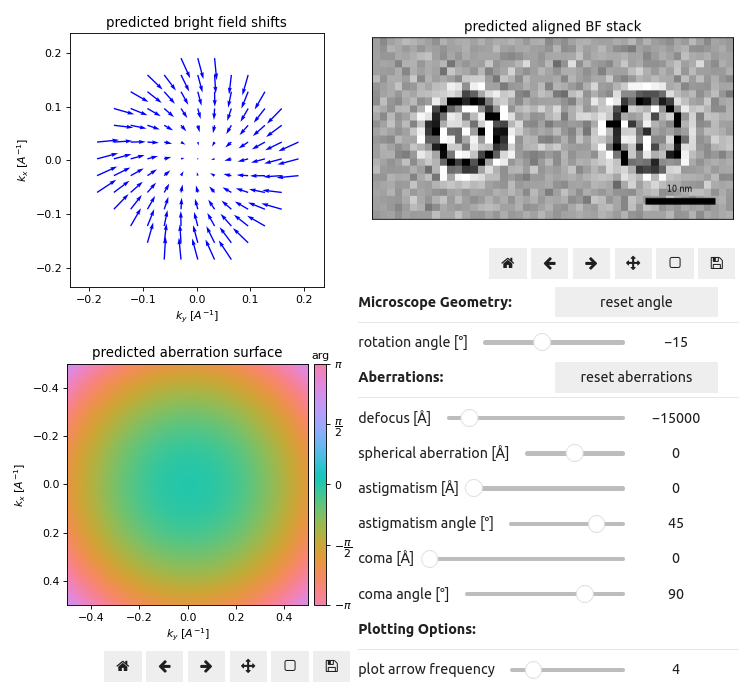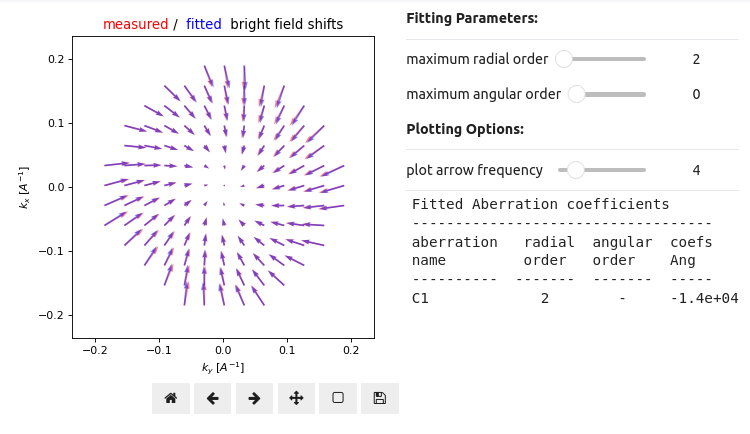Aberration Fitting
Aberration Surface Gradients¶
The cross-correlation vector shifts we computed in Cross-Correlation of Virtual Bright-Field Images are given by the gradient of the aberration surface Lupini et al., 2016
where is the 2D Fourier space coordinate (spatial frequency) and the aberration surface can be expressed using the following expansion Ophus et al., 2016
where λ is the (relativistically-corrected) electron wavelength, are the Cartesian aberration coefficients of radial order and angular order in units of ångströms.
Figure 1 investigates the effect of common aberrations and microscope geometry variations, away from the ground-truth values (relative rotation angle = -15°, and defocus = 1.5μm), on the apparent image shifts of virtual BF images and the aligned virtual BF stack.
Aberration Fitting¶
Equations (1) and (2) form a linear system of equations suggesting that, given the measured vector shifts , the aberration coefficients , and hence , can be estimated.
Specifically, we perform the following steps: Varnavides et al., 2023
- Estimate a 2x2 affine transformation, , which maps the initial BF pixel positions, , to the measured vector shifts, :
- Decompose the affine transform into radial, , and rotational, , components – from which the passive rotation θ can be estimated:
- Passively-rotate the Fourier coordinate system:
- Evaluate the linear system given by Equations (1) and (2) on to estimate aberration coefficients up to speficied radial and angular orders Cowley, 1979Lupini et al., 2010Lupini et al., 2016
Figure 2 performs the least-squares fit for various radial and angular orders, and plots a comparison between the measured and predicted vector shifts using the following py4DSTEM snippet:
parallax = parallax.aberration_fit(
fit_BF_shifts=True,
fit_aberrations_max_radial_order=2,
fit_aberrations_max_angular_order=0,
)- Lupini, A. R., Chi, M., & Jesse, S. (2016). Rapid aberration measurement with pixelated detectors. Journal of Microscopy, 263(1), 43–50. https://doi.org/10.1111/jmi.12372
- Ophus, C., Rasool, H. I., Linck, M., Zettl, A., & Ciston, J. (2016). Automatic software correction of residual aberrations in reconstructed HRTEM exit waves of crystalline samples. Advanced Structural and Chemical Imaging, 2, 1–10. https://doi.org/10.1186/s40679-016-0030-1
- Cowley, J. (1979). Coherent interference in convergent-beam electron diffraction and shadow imaging. Ultramicroscopy, 4(4), 435–449. https://doi.org/10.1016/S0304-3991(79)80021-2
- Lupini, A. R., Wang, P., Nellist, P. D., Kirkland, A. I., & Pennycook, S. J. (2010). Aberration measurement using the Ronchigram contrast transfer function. Ultramicroscopy, 110(7), 891–898. https://doi.org/10.1016/j.ultramic.2010.04.006



